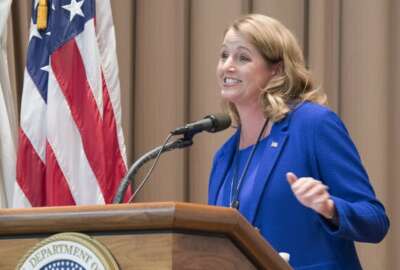
Have 30 minutes to spare? Plenty of time to craft a winning TMF funding idea
Come up with a great idea, draw up a business plan, then pitch it to a board of investors. Think of the Technology Management Fund board as Shark Tank for the...
Come up with a great idea, draw up a business plan, then pitch it to a board of investors. Think of the Technology Management Fund board as Shark Tank for the federal government.
The seven-member board, led by Federal Chief Information Officer Suzette Kent, has awarded nearly half of the $100 million fund created by the Modernizing Government Technology (MGT) Act last year.
So far, three agencies have gotten their IT modernization pitches approved, but what does it take to secure TMF funding for a project?
What about half an hour of brainstorming? That’s about all the time that Liz Cain, the executive director of the TMF program within the General Services Administration’s program management office, said agencies need to get an idea off the ground.
“Really, you only just need 30 minutes and that’s all you really need before you can talk to the team at TMF PMO,” Cain said Friday at an emerging technology conference at GSA’s headquarters in Washington. “Before you go to the [TMF] board, you need a really good initial project proposal, but to work with us, you can be in the very early stages of contemplating your project.”
The TMF loans out money to agencies looking to implement multi-year IT projects that don’t fit the mold of the annual congressional appropriations process.
“If we make a $10 million reward, they’re not taking out one of those big checks for $10 million,” Cain said. “You’re getting a little bit for your first sprint, a little bit for your second sprint, and oh by the way, if you don’t hit those milestones, you might not get that next distribution.”
But before making their pitch to the TMF board, agencies consult with the GSA PMO team, which helps them vet their ideas and draft an initial project proposal.
“Our job at the TMF PMO is to ensure that high-quality projects with the strongest likelihood to succeed make it into and through the TMF funding pipeline, and we can only do that if you work with us to ensure that your project proposals are the best that they can be,” Cain said.
The PMO team usually goes through about two rounds of review with each agency proposal, but Cain said some have taken up to four or five reviews to get ready.
Along the way, the team tells agencies where to go deeper in more technical detail with their proposals, or connect with other agency project teams that are working on similar projects.
“We will meet with any team that wants to meet with us, and that has been a really good strategy. You just have to have the time on your calendar that you are willing to meet with us. That’s really the only thing we’ll need,” Cain said.
After consulting with the PMO team, agencies go through the first round of TMF board vetting. That round includes submitting a two-or-three-page overview of the project idea and answering five basic questions about the project.
“I always joke that if you took your laptop and your cup of coffee, and you just sat down, you could write it in an hour, because most of the people who are submitting proposals are living and breathing their project every day,” Cain said.
12 agencies submit initial TMF proposals
TMF board gives a quick “thumbs up, thumbs down” vote on each initial proposal. This year, the board has received more than three dozen proposals from 12 agencies. There’s no limit to how many proposals an agency can submit.
“There’s no limit on how often an agency can come to the well,” Cain said. “We’ve had multiple agencies submit multiple proposals to the board for consideration. I would say we are seeing agencies think a little bit more about the proposals that they’re sending in, and thinking about if they’re sending in their strongest projects.”
Of those, about half make the cut from phase one to phase two of screening.
Once the board greenlights a project idea, agencies must draw up an 8-10 page “narrative” statement and submit a financial statement that calculates the expected return on investment the project will achieve.
The full project proposals require sign-off from a project lead, executive sponsor, as well as the agency’s chief information officer and chief financial officer.
Then finally, the agency makes a 10-minute, in-person pitch to the TMF board.
“[It’s] maybe a little bit like a venture capital pitch, maybe a little bit like the television show Shark Tank,” Cain said. “After that, the board asks them some pretty tough questions for about 20 minutes.”
This summer, the board awarded $45 million in funding to the departments of Agriculture, Energy and Housing and Urban Development.
Tips for making your TMF proposal
While there’s no perfect template for a TMF pitch, Cain shared some tips for what gets the board’s attention.
“They love to hear the citizen impact,” Cain said. “What is the story about how this affects the American people? Are you improving service? Are you reducing expenses? Are you able to stand up a new offering that helps people get a better service? All of those things can help strengthen your pitch to the board.”
Cain said board members also like to see agencies make an effort to stand up their projects before asking for TMF assistance.
“That could be something like a proof of concept or a pilot, or it could just be gathering information about your rough order of magnitude and your project scope,” Cain said. “All of that work can help show the board that you are ready to go on moving your project forward.”
The GSA PMO team also advises agencies to think like a board member — spelling out acronyms for systems that they might not be familiar with, or ensuring that everything is spelled correctly and uses good grammar.
“Those little things can help the board review your project, and you get a better chance of success,” Cain said.
When it comes to the remaining $55 million in the TMF, Cain said the board “is still working to review other project proposals,” and would make an announcement when it makes more awards.
Copyright © 2025 Federal News Network. All rights reserved. This website is not intended for users located within the European Economic Area.
Jory Heckman is a reporter at Federal News Network covering U.S. Postal Service, IRS, big data and technology issues.
Follow @jheckmanWFED
Related Stories





